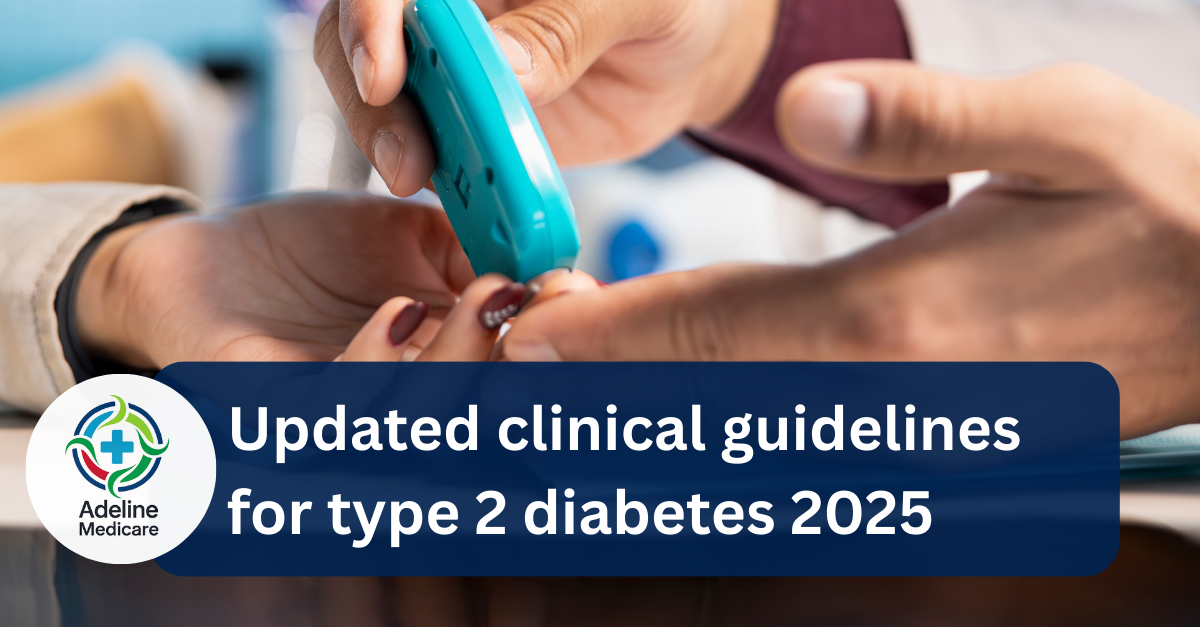
Updated Clinical Guidelines for Type 2 Diabetes 2025
Managing type 2 diabetes is becoming more advanced with every update to clinical guidelines. The updated clinical guidelines for type 2 diabetes 2025 provide a fresh roadmap for healthcare providers. These changes reflect new research, improved therapies, and better strategies for prevention. The aim is clear: improve patient outcomes, reduce complications, and create a patient-centered approach that fits real-world needs.
Why the 2025 Guidelines Matter
Diabetes continues to affect millions worldwide. Each year brings new evidence about what works best in treatment and prevention. The 2025 guidelines place stronger focus on weight management, technology, and early interventions. They also highlight the importance of tailoring treatment for each individual.
By following these updates, providers can deliver care that is not only effective but also practical for diverse patient populations.
Screening and Diagnosis
Early detection remains a top priority in the 2025 guidelines. The updates stress that at-risk groups should be screened earlier than before.
-
Adults over age 35 are recommended for regular screening.
-
Patients with obesity or a family history of diabetes should be screened at younger ages.
-
Communities with higher prevalence rates should receive special focus.
This change reflects the rising number of younger patients being diagnosed with type 2 diabetes. By finding the disease sooner, providers can start preventive strategies that delay or even stop its progression.
Personalized Glycemic Targets
The updated guidelines move away from one-size-fits-all goals. Instead, they emphasize personalization.
For most adults, the recommended A1C target remains below 7 percent. However, the guidelines recognize that not all patients benefit from strict control.
-
Younger adults with fewer health issues may aim for tighter control.
-
Older adults or those with complications may use a safer target between 7.5 and 8 percent.
This flexibility allows providers to balance benefits with risks such as hypoglycemia.
Lifestyle and Weight Management
One of the biggest updates in 2025 is the role of weight management as a disease-modifying factor. Research confirms that sustained weight loss can slow or even reverse type 2 diabetes in some cases.
Lifestyle changes remain the foundation:
-
Healthy eating patterns, such as Mediterranean-style diets.
-
At least 150 minutes of moderate physical activity per week.
-
Behavioral support to maintain long-term changes.
The guidelines also support new weight-loss medications and bariatric surgery in appropriate patients. This shift highlights the importance of addressing obesity as part of diabetes care.
Updated Pharmacologic Therapy
Medication recommendations have evolved to reflect new evidence.
-
Metformin remains the most common starting therapy.
-
GLP-1 receptor agonists and dual incretin therapies receive stronger recommendations. They lower blood sugar, support weight loss, and protect the heart.
-
SGLT2 inhibitors are advised for patients with heart failure, kidney disease, or high cardiovascular risk.
-
Insulin continues to play a role but is introduced when other treatments do not achieve goals.
These updates encourage providers to choose drugs not only for glucose control but also for broader health benefits.
Cardiovascular and Kidney Health
The 2025 guidelines highlight an integrated approach known as the organ protection triad: heart, kidneys, and weight.
Patients with type 2 diabetes often face higher risks of heart attack, stroke, and kidney disease. To address this, the guidelines recommend:
-
Using SGLT2 inhibitors for kidney and heart protection.
-
Prescribing GLP-1 receptor agonists for cardiovascular benefit.
-
Setting blood pressure goals below 130/80 mmHg for most patients.
-
Treating LDL cholesterol with statins, adjusting intensity based on risk.
By targeting these areas, providers can reduce long-term complications.
Advances in Technology
Technology plays a bigger role than ever in diabetes management. The 2025 updates expand recommendations for continuous glucose monitoring (CGM).
CGM is no longer limited to insulin-dependent patients. Many individuals with type 2 diabetes who use non-insulin therapies can now benefit. CGM provides real-time glucose data, reduces hypoglycemia, and improves overall control.
Digital health tools such as telemedicine and app-based coaching also receive support in the guidelines. These tools make care more accessible and patient-friendly.
Special Populations
The updated clinical guidelines for type 2 diabetes 2025 include focused strategies for groups with unique needs.
-
Pregnancy: Insulin remains the preferred therapy since it is safest for both mother and baby.
-
Older adults: Treatment plans should consider life expectancy and frailty. Simplified regimens are encouraged.
-
Ethnic groups: The guidelines stress awareness of cultural and genetic differences in disease risk and treatment response.
This ensures that care is inclusive and sensitive to patient diversity.
Social Determinants and Team-Based Care
Beyond medical therapy, the guidelines emphasize social factors. Access to healthy food, financial stability, and health literacy all affect diabetes outcomes. Providers are encouraged to screen for these issues and connect patients to community resources.
Team-based care also remains a strong theme. Physicians, dietitians, diabetes educators, and pharmacists should work together. This approach provides patients with the support they need for long-term success.
Practical Implementation Checklist
To make the guidelines easier to follow, providers can use a step-by-step approach:
-
Identify at-risk patients and screen early.
-
Set personalized A1C, blood pressure, and lipid targets.
-
Start with lifestyle interventions and add medications as needed.
-
Choose drug classes that address both blood sugar and organ protection.
-
Integrate technology like CGM where possible.
-
Adjust care plans for age, pregnancy, or cultural factors.
-
Address social determinants and provide education.
-
Reassess regularly and update goals as the patient’s needs change.
Final Thoughts
The updated clinical guidelines for type 2 diabetes 2025 represent an important step toward more individualized, patient-centered care. They reflect a future where treatment goes beyond controlling blood sugar. Providers now have clear direction to protect the heart, kidneys, and overall well-being of their patients.
With an emphasis on prevention, technology, and weight management, these guidelines equip healthcare teams to deliver care that is both advanced and practical. By adopting these recommendations, providers can help patients live longer, healthier lives with fewer complications.